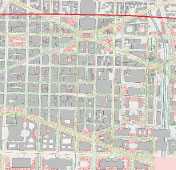Radiation Detection at Livermore Strengthens the World’s Counterterrorism and Nonproliferation Efforts
The Laboratory’s expertise in nuclear science, technology development, and field deployment contributes to countering the spread of nuclear weapons or radiological–nuclear terrorism.
Operational Experience Informs R&D
As a participant in the nation’s nuclear emergency response system, the Laboratory understands what capabilities are needed to respond effectively during a nuclear emergency and how to deploy those capabilities. This operational experience guides our radiation detection research and the solutions we provide.
Livermore deploys technical staff to support field nuclear emergencies, including the Fukushima Dai-ichi Nuclear Power Plant accident; provides technical reachback and home team support to deployed responders; analyzes materials and data returned from the field; and predicts and models plume dispersion. Laboratory staff help emergency planners prepare for and assess possible or actual consequences. Staff also train federal, state, local, and tribal law enforcement and emergency response organizations throughout the United States as well as international organizations such as the North Atlantic Treaty Organization, the International Atomic Energy Agency, and the Preparatory Commission for the Comprehensive Nuclear-Test-Ban Treaty Organization.
Expertise Feeds Threat Signature Prediction Capability
The Laboratory’s expertise in nuclear weapons design physics and source detection signatures, as well as computational modeling, enable us to assess the range of possible nuclear weapons threats. We have developed both classified and unclassified representative signature sets against which we and federal response programs can evaluate the performance of potential or deployed radiation detection systems, processes, and procedures.
- Surrogate nuclear models provide a broad view of nuclear and radiological radiation source signatures for validating modeled performance.
- Radiography surrogates are under development for assesssing the performance of x-ray and similar screening systems.
Next-Generation Radiation-Sensing Materials for Detection
Researchers at Livermore use their fundamental understanding of the interactions of radiation with matter to develop predictive models that aid discovery of new candidate radiation-sensing materials. One example is the development of strontium iodide (SrI2), a material that offers better energy-resolving performance than previous industry-standard sensing materials and is now appearing in commercial equipment.
Livermore researchers have also discovered the first-ever, energy-resolving plastic radiation-sensing material, which promises better efficiency as a large-size detector at potentially much lower production cost. Better energy resolution dramatically improves the ability to identify suspect radiation sources and reject nuisance alarms.
Advances in Signal Analysis
Livermore’s advanced signal analysis methods intelligently extract tiny radiation signals and distinguish them from those produced by naturally occurring radioactive materials and commonplace nuisance radiation sources, such as medical equipment. For example, our Radionuclide Analysis Kit (RNAK)—a suite of algorithms and tools—identifies radiation sources across multiple detector technologies and provides more accurate and complete analysis. RNAK was designated as the standard analysis engine for the Department of Homeland Security’s Wearable Intelligent Nuclear Detection program.
Another Livermore-developed algorithm improves searches for radioactive materials in cities. Called OPTUS (Optimization Planning Tool for Urban Search), the algorithm dramatically improves search speed from 3 to 30 times and easily adjusts to current traffic patterns and other conditions. OPTUS is being evaluated for implementation across the Department of Energy’s emergency response community. Further Improving Threat Detection Livermore researchers are implementing smarter signal analysis methods for reducing nuisance radiation alarms. Our Enhanced Radiological and Nuclear Inspection and Evaluation (ERNIE) machine-learning system makes better use of limited radiation signals to determine whether detection systems should alarm. Thus, the technology reduces nuisance alarms and increases detection sensitivity. Laboratory researchers are also developing higher performing detection materials that have recently been demonstrated in advanced radionuclide identification systems.
In addition, the Laboratory and select industrial partners are developing a concept of high-speed gravitational tomography to identify the presence of shielding in personal vehicles and other conveyances. The approach promises to identify the presence and location of significant shielding in personal vehicles within just a few seconds and would significantly complement existing passive radiation-screening techniques. Other efforts include developing lightweight, low-power versions of premier energy-resolving gamma detectors, which use high-purity germanium (HPGe). For years, we have developed and licensed electro-cooled HPGe-based detector systems. Our current efforts on the GeMini2 promise to yield a truly fieldable HPGe. By combining directional high-resolution gamma-ray detection (Compton and coded-aperture imaging) with an optical camera, Livermore also developed a system that identifies a source and places the source’s location and spatial characteristics in an operational context to enable responders to plan a course of action. Called the GeGI, the technology is now commercially available.
In an atmosphere of evolving threats and challenges, Livermore is well positioned to anticipate and deliver the technologies needed to help maintain global security.







